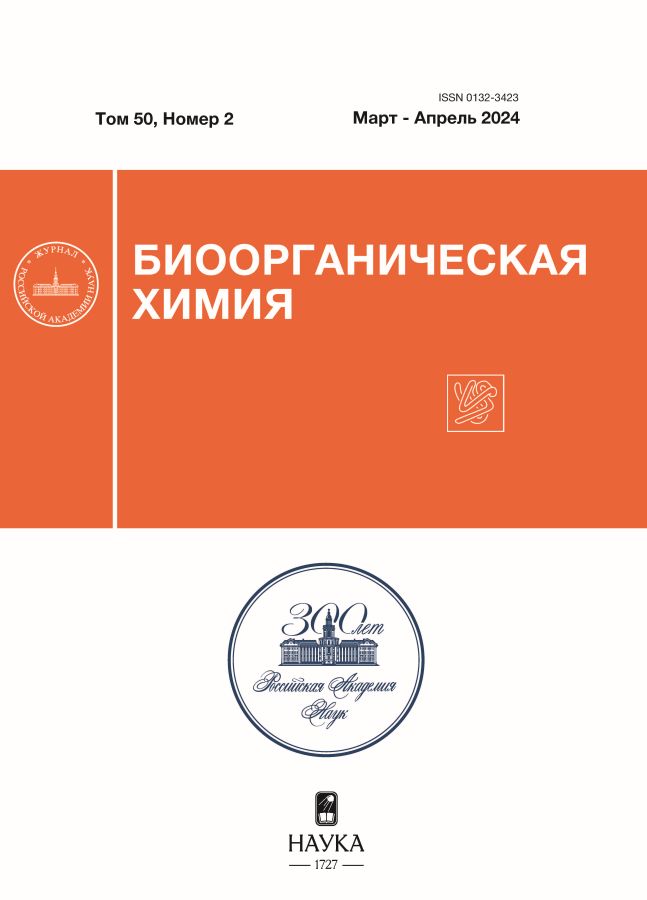Nanoparticles based on polyferylic and polygentisic acids as new carriers of anticancer drugs
- 作者: Smirnov I.V.1, Lisov A.V.2, Kazakov A.S.3, Zvonarev A.N.2, Suzina N.E.2, Zemskova M.Y.2
-
隶属关系:
- Skolkovo Institute of Science and Technology
- G.K. Skryabin Institute of Biochemistry and Physiology of Microorganisms, Russian Academy of Sciences
- Institute of Biological Instrumentation, Russian Academy of Sciences
- 期: 卷 50, 编号 2 (2024)
- 页面: 111-129
- 栏目: Articles
- URL: https://archivog.com/0132-3423/article/view/670947
- DOI: https://doi.org/10.31857/S0132342324020024
- EDN: https://elibrary.ru/ONQXQT
- ID: 670947
如何引用文章
详细
Lignin polymers and their derivatives are actively used in various fields of biomedicine to create biocompatible materials, as medications, and to form nanoparticles. However, natural polymeric compounds derived from plant materials or monomers are defined as a mixture of compounds having a high heterogeneity in chemical structure, which greatly complicates the determination of their biological activity. This paper describes a new method of controlled synthesis using the enzyme laccase, which can be applied to obtain polymers with a specific structure. Based on enzymatically synthesized lignin-like polymers from ferulic and gentisiс phenolic monomers, nanoparticles with stable properties under physiological conditions were formed. The nanoparticles can differ in morphology from globular to fibrillar structures, depending on monomers used in the enzymatic reaction and the method of their formation. Nanoparticles obtained from lignin-like polymers of ferulic and gentisic acids can be loaded with low molecular weight hydrophobic compounds, including the anticancer drug doxorubicin. It has been shown that polyferulic nanoparticles are actively penetrate in tumor cells growing both in a monolayer culture and as part of spheroids, and, compared with a free compound, doxorubicin in the composition of nanoparticles has a greater cytotoxic effect on breast cancer cells. These data indicate the possibility of effective use of these carriers as passive targeted drug delivery in the treatment of tumors.
全文:
作者简介
I. Smirnov
Skolkovo Institute of Science and Technology
编辑信件的主要联系方式.
Email: ivan_cmirnov_98@mail.ru
俄罗斯联邦, Moscow, 121205
A. Lisov
G.K. Skryabin Institute of Biochemistry and Physiology of Microorganisms, Russian Academy of Sciences
Email: ivan_cmirnov_98@mail.ru
俄罗斯联邦, 142290, Pushchino, prosp. Nauki, 5
A. Kazakov
Institute of Biological Instrumentation, Russian Academy of Sciences
Email: ivan_cmirnov_98@mail.ru
俄罗斯联邦, 142290, Pushchino, prosp. Nauki, 7
A. Zvonarev
G.K. Skryabin Institute of Biochemistry and Physiology of Microorganisms, Russian Academy of Sciences
Email: ivan_cmirnov_98@mail.ru
俄罗斯联邦, 142290, Pushchino, prosp. Nauki, 5
N. Suzina
G.K. Skryabin Institute of Biochemistry and Physiology of Microorganisms, Russian Academy of Sciences
Email: ivan_cmirnov_98@mail.ru
俄罗斯联邦, 142290, Pushchino, prosp. Nauki, 5
M. Zemskova
G.K. Skryabin Institute of Biochemistry and Physiology of Microorganisms, Russian Academy of Sciences
Email: marinazemskova9@gmail.com
俄罗斯联邦, 142290, Pushchino, prosp. Nauki, 5
参考
- Brigger I., Dubernet C., Couvreur P. // Adv. Drug Deliv. Rev. 2002. V. 54. P. 631–651. https://doi.org/10.1016/s0169-409x(02)00044-3
- Bozzuto G., Molinari A. // Int. J. Nanomed. 2002. V. 10. P. 975–999.
- Sharma A., Goyal A.K., Rath G. // J. Drug Target. 2017. V. 15. P. 1–16. https://doi.org/ 10.1080/1061186X.2017.1400553
- Cho C.F., Shukla S., Simpson E.J., Steinmetz N.F., Luyt L.G., Lewis J.D. // Methods Mol. Biol. 2014. V. 1108. P. 211–230. https://doi.org/10.1007/978-1-62703-751-8_16
- Lomis N., Westfall S., Farahdel L., Malhotra M., Shum-Tim D., Prakash S. // Nanomaterials (Basel). 2016. V. 6. P. 116. https://doi.org/10.3390/nano6060116
- Jain A.K., Das M., Swarnakar N.K., Jain S. // Crit. Rev. The Drug Carrier Syst. 2011. V. 28. P. 1–45. https://doi.org/10.1615/critrevtherdrugcarriersyst.v28.i1.10
- Frangville C., Rutkevičius M., Richter A.P., Velev O.D., Stoyanov S.D., Paunov V.N. // ChemPhysChem. 2012. V. 13. P. 4235–4243. https://doi.org/10.1002/cphc.201200537
- Figueiredo P., Ferro C., Kemell M., Liu Z., Kiriazis A., Lintinen K., Florindo H.F., Yli-Kauhaluoma J., Hirvo- nen J., Kostiainen M.A., Santos H.A. // Nanomedicine. 2017. V. 2017. P. 0219. https://doi.org/10.2217/nnm-2017-0219
- Lisova Z.A., Lisov A.V., Leontievsky A.A. // J. Basic Microbiol. 2010. V. 50. P. 72–82. https://doi.org/10.1002/jobm.200900382
- Fei Z., Chen F., Zhong M., Qiu J., Li W., Sadeghzadeh S.M. // RSC Adv. 2019. V. 9. P. 28078–28088. https://doi.org/10.1039/c9ra05079e
- Kishimoto T., Uraki Y., Ubukata M. // Org. Biomol. Chem. 2006. V. 4. P. 1343–1347. https://doi.org/10.1039/B518005H
- Alavi M., Hamidi M. // Drug Metabol. Personalized Ther. 2019. V. 34. 0032. https://doi.org/10.1515/dmpt-2018-0032
- O’Reilly R.K., Pearce A.K. // Bioconjug. Chem. 2019. V. 30. P. 2300–2311. https://doi.org/10.1021/acs.bioconjchem.9b00456
- Nahyeon L., Yong T.K., Jechan L. // Polymers (Basel). 2021. V. 13. P. 364. https://doi.org/10.3390/polym13030364
- Mikolasch A., Schauer F. // Appl. Microbiol. Biotechnol. 2009. V. 82. P. 605–624. https://doi.org/10.1007/s00253-009-1869-z
- Zheng Y., You X., Guan S., Huang J., Wang L., Zhang J., Wu J. // Adv. Funct. Mater. 2019. № 15. P. 1808646. https://doi.org/10.1002/adfm.201808646
- Leo E., Cameroni R., Forni F. // Int. J. Pharm. 1999. V. 180. P. 23–30. https://doi.org/10.1016/s0378-5173(98)00401-3
- Swietach P., Vaughan-Jones R.D., Harris A.L., Hulikova A. // Philos. Trans. R Soc. Lond. B Biol. Sci. 2014. V. 369. P. 20130099. https://doi.org/10.1098/rstb.2013.0099
- Ruan G., Agrawal A., Marcus A.I., Nie S. // J. Am. Chem. Soc. 2007. V. 129. P. 14759–14766. https://doi.org/10.1021/ja074936k
- Efeoglu E., Keating M.E., McIntyre J., Casey A., Byrne H. // Anal. Methods. 2015. № 23. Р. 10000– 10017.
- Dai X., Cheng H., Bai Z., Li J. // J. Cancer. 2017. V. 8. P. 3131–3141. https://doi.org/ 10.7150/jca.18457
- Xiao M., Hasmim M., Lequeux A., Moer K.V., Tan T.Z., Gilles C., Hollier B.G., Thiery J.P., Berchem G., Janji B., Noman M.Z. // Cancers (Basel). 2021. V. 13. P. 1165.
- Rystsov G.K., Lisov A.V., Zemskova M.Yu. // Russ. J. Bioorg. Chem. 2023. V. 49. P. 65–78. https://doi.org/10.31857/S0132342322060197
- Guerrini L., Alvarez-Puebla R., Pazos-Perez N. // Materials. 2018. V. 11. P. 1154. https://doi.org/10.3390/ma11071154
补充文件

















